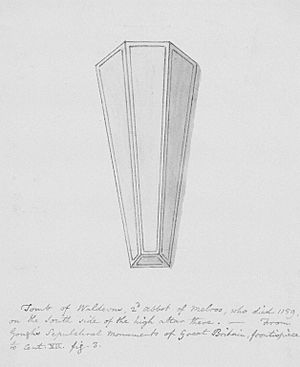Waltheof of Melrose facts for kids
Quick facts for kids Waltheof |
|
|---|---|
| Abbot of Melrose | |

19th century sketch of Waltheof's 12th century tomb
|
|
| Enthroned | 1148 |
| Reign ended | 1159 |
| Predecessor | Richard |
| Successor | William |
| Personal details | |
| Born | c. 1095 probably Huntingdon or Northamptonshire |
| Died | 3 August 1159 (aged c. 64) Melrose |
| Buried | Melrose Abbey |
| Parents | Simon I of St Liz, 1st Earl of Northampton Maud, 2nd Countess of Huntingdon |
| Sainthood | |
| Feast day | 3 August |
| Patronage | Melrose Abbey, Northamptonshire |
Waltheof (born around 1095 – died 1159) was an important English church leader in the 1100s. He became known as a saint after his death. Waltheof was the son of Simon I of St Liz, 1st Earl of Northampton and Maud, 2nd Countess of Huntingdon. This made him the stepson of David I of Scotland, who was a king. He was also the grandson of another important person named Waltheof, Earl of Northampton.
Contents
Waltheof's Early Life and Church Career
Waltheof was a younger son in his family. In those days, younger sons often joined the church because they wouldn't inherit their family's land or titles. Waltheof chose this path.
Becoming a Canon and Prior
Between 1128 and 1131, Waltheof joined Nostell Priory. Here, he became an Augustinian canon. A canon is a type of priest who lives in a community. Because of his noble family, Waltheof quickly moved up in the church. Within a few years, he became the Prior of Kirkham in North Yorkshire. A prior is the head of a priory, which is a type of monastery.
The Archbishop of York Election
In 1140, the Archbishop of York, Thurstan, passed away. Waltheof was suggested as the next archbishop. He had the support of William of Aumale, who was a powerful earl. However, King Stephen did not agree. The king worried that Waltheof's family connections to King David of Scotland and Empress Matilda were too strong. These two were rivals to King Stephen.
William of Aumale also stopped supporting Waltheof. This happened after Waltheof refused to promise the earl a church property. In the end, William fitz Herbert was chosen instead. Waltheof was one of the main people who disagreed with this choice.
Becoming a Cistercian Monk and Abbot
By 1143, Waltheof decided to leave the arguments behind. He became a Cistercian monk at Rievaulx Abbey. Cistercian monks live a very strict and simple life. In 1148, he was chosen to be the abbot of Melrose. Melrose Abbey was a "daughter house" of Rievaulx, meaning it was founded by monks from Rievaulx.
Waltheof stayed as abbot of Melrose for the rest of his life. In 1159, he was offered the important job of bishop of St Andrews. However, he turned it down. Waltheof died at Melrose Abbey on August 3, 1159.
Waltheof's Sainthood
After Waltheof died, people started saying he was a saint. His successor as abbot, Abbot William, did not want to encourage these stories. He tried to stop the rumors and prevent people from coming to visit Waltheof's tomb. These visitors were called pilgrims.
The Opening of Waltheof's Tomb
However, Abbot William could not stop the growing belief that Waltheof was a saint. His actions made his fellow monks unhappy. So, in April 1170, William resigned as abbot. Jocelin, who was the prior of Melrose, became the new abbot. Jocelin fully supported the idea of Waltheof being a saint.
In the year Jocelin became abbot, the Chronicle of Melrose reported something amazing. It said that Waltheof's tomb was opened on May 22, 1170. This was twelve years after his death. The report stated that Waltheof's body was found whole, and his clothes were still in good condition. After a special church service, a new, shiny marble stone was placed over his tomb. Everyone present was very happy and said that Waltheof was truly a man of God.
Promoting Waltheof's Legacy
Jocelin later became the Bishop of Glasgow. He continued to promote saints. He even asked someone to write a special book about Saint Kentigern, another important saint. It's interesting that the same person, Jocelin of Furness, wrote both the Life of St. Waltheof and the Life of St. Kentigern.
Jocelin's efforts made sure that Waltheof was seen as a saint after his death. Melrose Abbey also wanted to have its own saint. This helped Waltheof's story and belief in his sainthood last for a long time.
Images for kids


